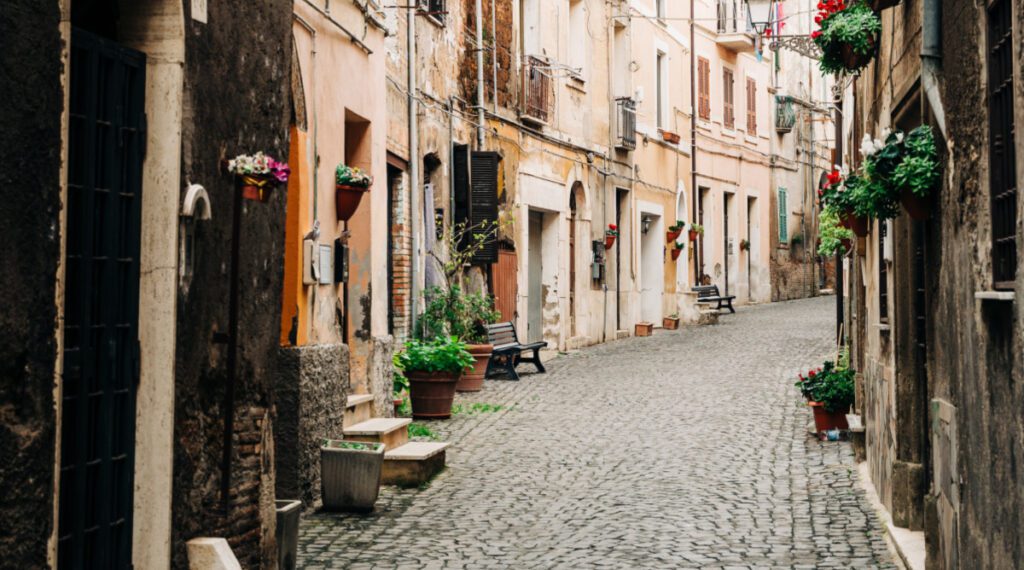The Catholic Church is bustling with saints; if you search the calendar for feast days, you’ll see that there are about a dozen saints for nearly every day of the year.
Not only that, but many have been awarded the “patron saint of …” Feel free to fill in the blank like a crazy Mad Lib, because no matter what you write there will likely be a saint attached to it. For example …
Isidore of Seville, who lived a few years before computers were invented (he died in 636 A.D.), is the patron of the internet. Go figure.
St. Mathurin, a second-century Gallo-Roman exorcist, is the patron saint of clowns. That one I totally understand …
Some saints are well-known, and many are revered by Christians and non-Christians alike, such as St. Hildegard of Bingen, St. Teresa of Avila, and Saint Francis of Assisi.
Most Catholic saints, however, remain relatively unknown—until they’re discovered again.
Heading out of Assisi and driving just a few dozen kilometers to the west, the quaintly fabulous hilltop town of Montefalco remains typically Italian—quiet, languid, in no rush to do anything except socialize over a glass of amazingly complex, yet distinctly down-to-earth, wine. Known for being the only region in the world native to the lushly rich Sagrantino grape, the tiny Italian village of Montefalco boasts another attraction, although many people don’t realize it.
I certainly didn’t, until I stumbled upon Montefalco’s main square. Just off a side street is a medieval stone church, quaint and lovely. Inside the church rests the incorrupt body the village’s most venerable citizen, St. Chiara of Montefalco (in English she’s most often referred to as St. Clare of the Cross).
Who was this person? you may ask. At least that’s what I wondered the first time I discovered Montefalco. (The GPS was leading me toward “Wineries” rather than “Refusing to Rot Saints,” so I was in for a bit of a surprise.)
Who was she, and what did this Chiara gal do to deserve sainthood?
That’s the thing. Most of the thousands of officially declared saints (over 10,000 at last count) didn’t actually do anything, at least not to the standards of St. Mother Teresa heroics. Yes, they led pious lives, but what else did they do?
Many led quite simple lives, such as St. Thérèse of the Child Jesus, who died at the age of 24 and never left her hometown.
St. Clare of Montefalco was likely named in honor of the saint-down-the-street, Clare of Assisi. Born around 1268 (fifteen years after St. Clare of Assisi’s death), this humble girl from Montefalco didn’t change the world. She didn’t work with the saint of peace to help bring love to millions, as did her namesake. She didn’t travel to Avignon to convince the pope to return to Rome like St. Catherine of Siena, nor did she produce great mystical works that people today still benefit from, like Sts. Teresa of Avila or John of the Cross.
So what, then, did actually she do?
Clare’s incredible legacy was that she was so close to Christ her heart was pierced as she remembered the torture He suffered for humankind. During a vision received in spiritual ecstasy, she saw her heart literally wounded because of her unfailing love as mirrored in the love of Christ, her Divine Bridegroom.
After that experience, she lived with a sharp pain in her chest until her death in 1308.
When her body was cut open in a church-sanctified autopsy, the image of a crucifix is said to have been discovered etched on her heart. Unbelieving, the bishop of Spoleto suspected that the images had been carved by her devoted followers and not the hand of God. He demanded that her heart be cut up, wanting to destroy the evidence so as to avoid false piety and veneration of her remains.
However, when Clare’s heart was sliced in half, the sacred image remained—and was duplicated on the cut-off pieces. Today she rests in her Montefalco church, visible to those who make an appointment to view her saintly remains.
Despite the fact that she died in the tumultuous 14th century and no embalming methods were used, Clare is one of the many saints who failed to decay as normal humans are prone to do after death.
Instead, sweet aromas—such as almond blossom or rose—are said to emanate from the physically lifeless bodies of incorrupt saints. This mirrors the sweet aroma of our Divine Bridegroom, the comforting presence of His love and grace.
Delicate is the fragrance of Your perfume,
Your Name is an oil poured out,
and that is why the maidens love you …
We shall praise your love above wine;
how right it is to love you.
(Song of Songs 1:3)
This Biblical quote is perfect for St. Clare of Montefalco.
Wine growing, cultivation, production, and tasting have long been passions of mine. When I learned that Montefalco was the only place in the world where the Sagrantino grape is natively grown, I was determined to visit. This is a rare fruit, not prone to the diseases that befall other grape varietals (which is a theological reflection in itself), and has been traditionally used as Eucharistic wine. It’s special, it’s unique, it’s filled with the love of the Divine Bridegroom.
The grapes of the Sagrantino variety are those that—in Italy at least—have traditionally been transubstantiated into the Blood of Christ. St. Clare of Montefalco was so close to the Blood of her Divine Bridegroom that His passion was inscribed upon her heart.
Coincidence? I think not. The Holy Spirit is not a Spirit of coincidence but of intentionality and Divine Grace.
________________________________________________________________________________________
To learn about author Jenny duBay’s Rosary Campaign to end and heal Domestic Violence–especially during October, the month of the Holy Rosary–please visit CreateSoulSpace.net.
This post was first published on Missio Dei and is reprinted here with permission.
Image courtesy of Unsplash.




